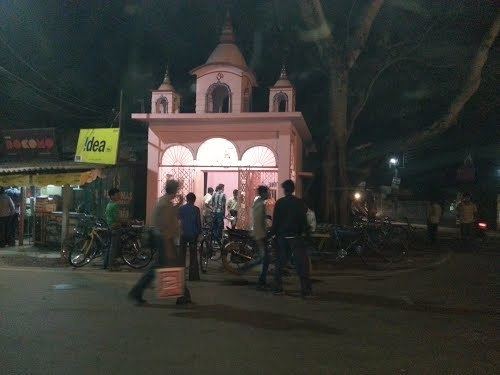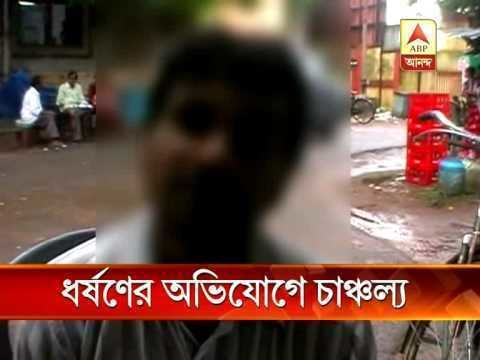Vehicle registration WB-34 Area 168.3 km² Literacy 84% Area code 03225 | Time zone IST (UTC+5:30) Elevation 9 m Population 203,987 (2011) | |
 | ||
Weather 23°C, Wind SW at 8 km/h, 61% Humidity | ||
Daspur I is a community development block that forms an administrative division in Ghatal subdivision of Paschim Medinipur district in the Indian state of West Bengal.
Contents
- Geography
- Population
- Literacy
- Language and religion
- BPL families
- Infrastructure
- Agriculture
- Banking
- Transport
- Education
- Healthcare
- References

Geography
In Daspur I CD Block, the area is a flat deltaic country intersected by numerous rivers and water courses. It is a flood prone area and is affected by water logging in the rainy season. 100% of the cultivated area has highly productive alluvial soil.
Daspur is located at 22°36′18″N 87°43′19″E.

Daspur I CD Block is bounded by Ghatal CD Block in the north, Daspur II CD Block in the east, Panskura I CD Block, in Purba Medinipur district, in the south and Keshpur CD Block in the west.
It is located 52 km from Midnapore, the district headquarters.
Daspur I CD Block has an area of 168.30 km2. It has 1 panchayat samity, 10 gram panchayats, 161 gram sansads (village councils), 162 mouzas and 157 inhabited villages. Daspur police station serves this block. Headquarters of this CD Block is at Daspur.

Gram panchayats of Daspur I block/ panchayat samiti are: Basudevpur, Daspur I, Daspur II, Nandanpur I, Nandanpur II, Nij-Narajole, Panchberia, Rajnagar, Sarberia I and Sarberia II.
Population

As per the 2011 Census of India Daspur I CD Block had a total population of 203,987, all of which were rural. There were 103,757 (51%) males and 100,230 (49%) females. Population below 6 years was 22,797. Scheduled Castes numbered 49,651 (24.34%) and Scheduled Tribes numbered 5,695 (2.79%).
As per 2001 census, Daspur I block had a total population of 175,331, out of which 86,872 were males and 88,459 were females. Daspur I block registered a population growth of 10.60 per cent during the 1991-2001 decade. Decadal growth for the combined Midnapore district was 14.87 per cent. Decadal growth in West Bengal was 17.45 per cent.
Large villages (with 4,000+ population) in Daspur I CD Block are (2011 census figures in brackets): Nij Narajol (4,085) and Rajnagar (4,890).
Other villages in Daspur I CD Block include (2011 census figures in brackets): Daspur (3,667), Panchberya (2,164), Sarberya (1,058), Nandanpur (810) and Basudebpur (3,160).
Literacy
As per the 2011 census the total number of literates in Daspur I CD Block was 152,189 (83.99% of the population over 6 years) out of which males numbered 83,778 (90.87% of the male population over 6 years) and females numbered 68,411 (76.87% of the female population over 6 years). The gender gap in literacy rates was 13.99%.
As per the 2011 census, literacy in Paschim Medinipur district was 78.00%. Literacy in West Bengal was 77.08% in 2011. Literacy in India in 2011 was 74.04%.
See also – List of West Bengal districts ranked by literacy rate
Language and religion
Bengali is the local language in these areas.
In the 2011 census Hindus numbered 191,501 and formed 93.88% of the population in Daspur I CD Block. Muslims numbered 12,171 and formed 5.97% of the population. Others numbered 315 and formed 0.15% of the population. Others include Addi Bassi, Marang Boro, Santal, Saranath, Sari Dharma, Sarna, Alchchi, Bidin, Sant, Saevdharm, Seran, Saran, Sarin, Kheria,. Christians and other religious communities.
BPL families
In Daspur I CD Block 22.16% families were living below poverty line in 2007.
According to the District Human Development Report of Paschim Medinipur: The 29 CD Blocks of the district were classified into four categories based on the poverty ratio. Nayagram, Binpur II and Jamboni CD Blocks have very high poverty levels (above 60%). Kharagpur I, Kharagpur II, Sankrail, Garhbeta II, Pingla and Mohanpur CD Blocks have high levels of poverty (50-60%), Jhargram, Midnapore Sadar, Dantan I, Gopiballavpur II, Binpur I, Dantan II, Keshiari, Chandrakona I, Gopiballavpur I, Chandrakona II, Narayangarh, Keshpur, Ghatal, Sabang, Garhbeta I, Salboni, Debra and Garhbeta III CD Blocks have moderate levels of poverty (25-50%) and Daspur II and Daspur I have low levels of poverty (below 25%).
Infrastructure
156 or 96% of mouzas in Daspur I CD block were electrified by 31 March 2014.
162 mouzas in Daspur I CD Block had drinking water facilities in 2013-14. There were 137 fertiliser depots, 130 seed stores and 40 fair price shops in the CD Block.
Agriculture
Although the Bargadari Act of 1950 recognised the rights of bargadars to a higher share of crops from the land that they tilled, it was not fully implemented. Large tracts, beyond the prescribed limit of land ceiling, remained with the rich landlords. From 1977 onwards major land reforms took place in West Bengal. Land in excess of land ceiling was acquired and distributed amongst the peasants.Following land reforms land ownership pattern has undergone transformation. In 2013-14, persons engaged in agriculture in Daspur I CD Block could be classified as follows: bargadars 7.74%, patta (document) holders 10.40%, small farmers (possessing land between 1 and 2 hectares) 3.33%, marginal farmers (possessing land up to 1 hectare) 37.84% and agricultural labourers 40.69%.
In 2005-06 the nett cropped area in Daspur I CD Block was 13,200 hectares, out of a geographical area of 16,719 hectares, and the area in which more than one crop was grown was 12,826 hectares.
The extension of irrigation has played a role in growth of the predominantly agricultural economy.In 2013-14, the total area irrigated in Daspur I CD Block was 8,940 hectares, out of which 220 hectares were irrigated by tank water, 4,980 hectares by deep tubewells, 10 hectares by shallow tubewells, 780 hectares by river lift irrigation and 2,950 hectares by other methods.
In 2013-14, Daspur I CD Block produced 1,022 tonnes of Aman paddy, the main winter crop, from 2,219 hectares, 1,239 tonnes of Aus paddy (summer crop) from 535 hectares, 25,927 tonnes of Boro paddy (spring crop) from 8,335 hectares, 6,423 tonnes of jute from 511 hectares and 37,180tonnes of potatoes from 1,893 hectares. It also produced oilseeds.
Banking
In 2013-14, Daspur I CD Block had offices of 9 commercial banks and 1 gramin bank.
Transport
Daspur I CD Block has 17 ferry services and 4 originating/ terminating bus routes. The nearest railway station is 30 km from the CD Block headquarters.
Education
In 2013-14, Daspur I CD Block had 129 primary schools with 11,222 students, 5 middle schools with 324 students, 15 high schools with 6,370 students and 14 higher secondary schools with 15,171 students. Daspur I CD Block had 1 general college with 626 students, 2 technical/ professional institutions with 221 students, 327 institutions for special and non-formal education with 12,111 students.
The United Nations Development Programme considers the combined primary and secondary enrolment ratio as the simple indicator of educational achievement of the children in the school going age. The infrastructure available is important. In Daspur I CD Block out of the total 129 primary schools in 2008-2009, 48 had pucca buildings, 45 partially pucca and 36 multiple type.
Narajole Raj College at Narajole was established in 1966 and is affiliated to Vidyasagar University. It offers undergraduate courses in science and arts. It has started a post-graduate course in Bengali.
Healthcare
In 2014, Daspur I CD Block had 1 rural hospital, 2 primary health centres and 8 private nursing homes with total 76 beds and 11 doctors. It had 31 family welfare sub centres and 1 family welfare centre. 2,100 patients were treated indoor and 107,659 patients were treated outdoor in the hospitals, health centres and subcentres of the CD Block.
